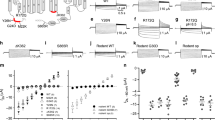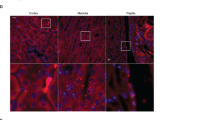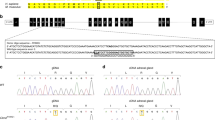Abstract
CLC-K1 is a kidney-specific chloride channel that mediates transepithelial chloride transport in the thin ascending limb of Henle's loop (tAL) in the inner medulla 1, 2 . Transport of NaCl in the tAL is thought to be a component of urinary concentration in a passive model of the countercurrent multiplication system 3, 4, 5 , but there has been no direct evidence that CLC-K1 is involved in urine concentration. To analyse the physiological function of CLC-K1 in vivo , we generated mice lacking CLC-K1 by targeted gene disruption. Clcnk1 –/– mice were physically normal appearance, but produced approximately five times more urine than Clcnk1 +/– and Clcnk1 +/+ mice. After 24 hours of water deprivation, Clcnk1 –/– mice were severely dehydrated and lethargic, with a decrease of approximately 27% in body weight. Intraperitoneal injection of the V2 agonist 1-deamino-8-D-arginine vasopressin (dDAVP) induced a threefold increase in urine osmolarity in Clcnk1 +/– and Clcnk1 +/+ mice, whereas only a minimal increase was seen in Clcnk1 –/– mice, indicating nephrogenic diabetes insipidus. After in vitro perfusion of the tAL, the lumen-to-bath chloride gradient did not produce a diffusion potential in Clcnk1 –/– mice in contrast to Clcnk1 +/+ and Clcnk1 +/– mice. These results establish that CLC-K1 has a role in urine concentration, and that the countercurrent system in the inner medulla is involved in the generation and maintenance of hypertonic medullary interstitium.
This is a preview of subscription content, access via your institution
Access options
Subscribe to this journal
Receive 12 print issues and online access
$209.00 per year
only $17.42 per issue
Buy this article
- Purchase on Springer Link
- Instant access to full article PDF
Prices may be subject to local taxes which are calculated during checkout




Similar content being viewed by others
References
Uchida, S. et al. Molecular cloning of a chloride channel that is regulated by dehydration and predominantly expressed in kidney medulla. J. Biol. Chem. 268, 3821–3824 ( 1993).
Uchida, S. et al. Localization and functional characterization of rat kidney-specific chloride channel, ClC-K1. J. Clin. Invest. 95, 104–113 (1995).
Imai, M. & Kokko, J.P. Mechanism of sodium and chloride transport in the thin ascending limb of Henle. J. Clin. Invest. 58, 1054–1060 ( 1976).
Kokko, J.P. & Rector, F.C. Jr Countercurrent multiplication system without active transport in inner medulla. Kidney Int. 2, 214–223 ( 1972).
Imai, M., Taniguchi, J. & Tabei, K. Function of thin loop of Henle. Kidney Int. 31, 565–579 ( 1987).
Simon, D.B. et al. Mutations in the chloride channel gene, CLCNKB, cause Bartter's syndrome type III. Nature Genet. 17, 171–178 (1997).
Kieferle, S., Fong, P., Bens, M., Vandewalle, A. & Jentsch, T.J. Two highly homologous members of the ClC chloride channel family in both rat and human kidney. Proc. Natl Acad. Sci. USA 91, 6943–6947 ( 1994).
Takeuchi, Y., Uchida, S., Marumo, F. & Sasaki, S. Cloning, tissue distribution, and intrarenal localization of ClC chloride channels in human kidney. Kidney Int. 48,1497– 1503 (1995).
Kondo, Y., Yoshitomi, K. & Imai, M. Effect of anion transport inhibitors and ion substitution on Cl transport in the thin ascending limb of Henle's loop. Am. J. Physiol. 253, F1206–F1215 (1987).
Kondo, Y., Yoshitomi, K. & Imai, M. Effect of pH on Cl- transport in the thin limb ascending limb of Henle's loop. Am. J. Physiol. 253, F1216–F1222 (1987).
Yoshitomi, K., Kondo, Y. & Imai, M. Evidence for conductive Cl pathways across the cell membranes of the thin ascending limb of Henle's loop. J. Clin. Invest. 82 , 866–871 (1988).
Lolait, S.J. et al. Cloning and characterization of a vasopressin V2 receptor and possible link to nephrogenic diabetes insipidus. Nature 357, 336–339 (1992).
Rosenthal, W. et al. Molecular identification of the gene responsible for congenital nephrogenic diabetes insipidus. Nature 359, 233–235 (1992).
Deen, P.M.T. et al. Requirement of human renal water channel aquaporin-2 for vasopressin-dependent concentration of urine. Science 264, 92–95 (1994).
Acknowledgements
We thank K. Nakayama and K.-i. Nakayama for helpful advice. This work was supported by grants-in-aid from the Ministry of Education, Science, Sports and Culture of Japan.
Author information
Authors and Affiliations
Corresponding author
Rights and permissions
About this article
Cite this article
Matsumura, Y., Uchida, S., Kondo, Y. et al. Overt nephrogenic diabetes insipidus in mice lacking the CLC-K1 chloride channel. Nat Genet 21, 95–98 (1999). https://doi.org/10.1038/5036
Received:
Accepted:
Issue Date:
DOI: https://doi.org/10.1038/5036
This article is cited by
-
Clues and new evidences in arterial hypertension: unmasking the role of the chloride anion
Pflügers Archiv - European Journal of Physiology (2022)
-
Role of PKC in the Regulation of the Human Kidney Chloride Channel ClC-Ka
Scientific Reports (2020)
-
Bartter and Gitelman syndromes: Questions of class
Pediatric Nephrology (2020)
-
A case of hypokalemia and proteinuria with a new mutation in the SLC12A3 Gene
BMC Nephrology (2018)
-
In silico model of the human ClC-Kb chloride channel: pore mapping, biostructural pathology and drug screening
Scientific Reports (2017)



